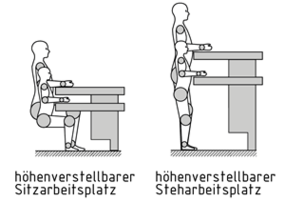
Wählen Sie eine
oder mehrere Sprachen aus
0,1,0
- Deutsch
- Englisch
- Chinesisch
- Spanisch
Arbeitsplatz-Grundtyp

Die Arbeitsplatz-Grundtypen werden nach der dominierenden Körperhaltung unterschieden:
- Sitz-Arbeitsplatz
- Sitz-und Steh-Arbeitsplatz
- Steh-Arbeitsplatz
Alle Typen sind in nicht höhenverstellbar (mit oder ohne Anpassung ans 95% Perzentil) und höhenverstellbar weiter gegliedert.
Die Art der Tätigkeiten bestimmt mehr als die Körpermaße die optimale Höhe eines Steharbeitsplatzes. Bei höheren Anforderungen an Hand- und Armkräfte richtet sie sich nach der optimalen Armhaltung: Bei aufrechter Körperhaltung und senkrechten Oberarmen sollen Ober- und Unterarme einen rechten Winkel, Blick- und Kopfneigung einen Gesamtwinkel von etwa 35° ergeben.
Am Sitzarbeitsplatz müssen Fehlbeanspruchungen von Nacken, Schultergürtel und Rücken sowie Zwangshaltungen von Armen und Beinen vermieden werden. Eine Haltung mit aufrechtem Oberkörper, senkrechten Oberarmen und Unterschenkeln, waagerechten Unterarmen und Oberschenkeln, flächigem Fuß-Boden-Kontakt sowie ein etwa um 40° gesenkter Blickwinkel gelten als optimal.
Basic workstation type

The basic workstation types are defined according to the dominant posture:
- Sitting workstation
- Sitting/standing workstation
- Standing workstation
These types are further subdivided into fixed-height (with or without adjustment to the 95% percentile) and height-adjustable workstations.
The type of activity to be undertaken plays a more important role in determining the optimum height for a standing workstation than Body measurements. If higher demands are placed on hand and arm Strength, the workstation height is tailored to the optimum arm posture: when in a standing position with the upper arms hanging vertically, the upper and lower arms should be oriented in a right angle, while the line of sight and head should be tilted at an overall angle of around 35°.
At a sitting workstation, it is important to avoid strain on the neck, shoulders and back and prevent constrained arm and leg postures. The optimum sitting position features a straight upper body, vertical upper arms and lower legs, horizontal lower arms and upper legs, feet flat on the floor and a dipped viewing angle of around 40°.
工作台基本类型

工作台的基本类型根据人体的主要使用姿势,可定义为:
坐式工作台
坐式/站式工作台
站式工作台
这些类型还可以进一步细分为高度固定(95%高度范围不可调)和高度可调的工作台。
确定站式工作台的最佳高度时,在工作台上开展的活动类型比人体尺寸起到更重要的作用。如果对手和手臂的强度有更高的要求,工作台的高度要根据最佳手臂姿势定制:站式工作台中,上臂垂直悬空,上下臂之间以直角弯曲,视线和头部的整体倾斜角度约为 35°。
坐式工作台要避免引起颈部、肩部和背部的过度疲劳,防止手臂和腿部姿势受迫变形。最佳坐式是指上身挺直,大臂和小腿垂直,小臂和大腿水平,双脚平放在地面上,视角倾斜大约 40°。
工作台基本类型 - 高度可调和高度固定的坐式/站式工作台
Tipos básicos de estación de trabajo

Los tipos básicos de estaciones de trabajo se definen de acuerdo con la postura dominante:
Estación de trabajo sentado
Estación de trabajo sentado/de pie
Estación de trabajo de pie
Estos tipos se subdividen aún más en estaciones de trabajo de altura fija (con o sin ajustes en un 95 %) y de altura ajustable.
El tipo de actividad a desarrollar juega un rol más importante que las medidas del cuerpo a la hora de determinar la altura óptima para una estación de trabajo de pie. Si se aplican mayores demandas en la fuerza de la mano y el brazo, la altura de la estación de trabajo se diseña para una postura de brazo óptima: cuando se está de pie con los brazos colgando verticalmente, el brazo y el antebrazo deben estar orientados en un ángulo recto, mientras que la línea de visión y la cabeza deben inclinarse en un ángulo general de alrededor de 35°.
En una estación de trabajo sentado, es importante evitar la tensión en el cuello, los hombros y las espalda, y prevenir posturas restringidas para brazos y piernas. La posición sentada óptima cuenta con un cuerpo superior recto, brazo y pantorrillas rectas, antebrazos y muslos horizontales, pies planos sobre el piso y un ángulo de visión inclinado alrededor de 40°.
Tipos básicos de estaciones de trabajo - estaciones de trabajo sentado/de pie con altura ajustable y altura fija.
